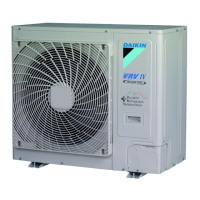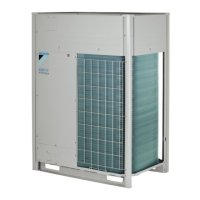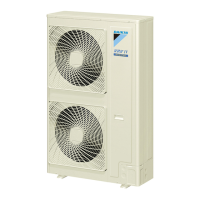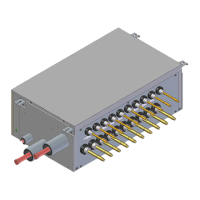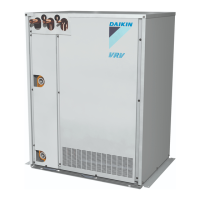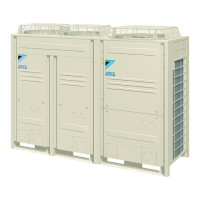<< Continuation of previous page << Continuation of previous page
Heating charging
( 22 startup control)
(
23 waiting for stable heating)
Cooling charging
( 02 startup control)
(
03 waiting for stable cooling)
23KUƃCUJKPI
r Push BS2 within 5 minutes.
r Open valve A.
03KUƃCUJKPI
r Push BS2 within 5 minutes.
r Open valve A.
Display show 23 and low pressure
value with an interval of 1 second.
r
Add additional refriger
ant amount
P (lbs.(kg)).
r Close valve A.
r Push BS3 to stop operation.
r 'PFKPIEQFG
26 will appear.
Display show
03 and low pressure
value with an interval of 1 second.
Refrigerant will be charged automati-
cally.
PEEJCTIKPIPGCTN[ƂPKUJGF
P9EJCTIKPIƂPKUJGF
OR
P(lbs.(kg)) was added during auto-
charge
R=Q+P
r Close valve A.
r Push BS1 to leave program.
r %JCTIKPIKUƂPKUJGF
r Fill in the amount on the additional
refrigerant charge label.
r Go to test run (see 15.4. Test opera-
VKQPQPRCIG|
r Push BS2.
rT
A
check will be performed.
r 0X will appear. (X is variable)
r Push BS1.
r %JCTIKPIKUƂPKUJGF
r Fill in the amount on the additional
refrigerant charge label.
r Go to test run (see 15.4. Test opera-
VKQPQPRCIG|
Following codes appear: E-2 (indoor
temperature out of range) and E-3
(outdoor temperature out of range).
r Push BS1 to leave program.
r %JCTIKPIKUƂPKUJGF
r Fill in the amount on the additional
refrigerant charge label.
r Go to test run (see 15.4. Test opera-
VKQPQPRCIG|
During gray
conditions
If following codes appear: E-2 (indoor
temperature out of range) and E-3
(outdoor temperature out of range).
In this case, perform automatic charg-
ing procedure again.
5GGƂIWTG.QECVKQPQHXCNXGUPGZVRCIGHQTOQTGKPHQTOCVKQPTGHGTVQ
VJGVGZVKPVJKUEJCRVGT
$GUWTGVQEJCTIGVJGURGEKƂGFCOQWPVQHTGHTKIGTCPVKPNKSWKFUVCVG
5KPEGVJKUTGHTKIGTCPVKUCOKZGFTGHTKIGTCPVCFFKPIKVKPICUHQTO
may cause the refrigerant composition to change, preventing normal
operation.
r
Before charging, chec
k whether the refrigerant cylinder is equipped
with a siphon tube or not.
Charge the liquid
refrigerant with the
cylinder in upright
position.
Charge the liquid
refrigerant with the
cylinder in upside-
down position.
r $GUWTGVQWUGVQQNUGZENWUKXGN[HQT4#VQGPUWTGTGSWKTGFRTGU-
UWTGTGUKUVCPEGCPFVQRTGXGPVHQTGKIPOCVGTKCNUHTQOOKZKPIKPVQ
the system.
NOTE
%JCTIKPIYKVJCPWPUWKVCDNGUWDUVCPEGOC[ECWUGGZRNQUKQPUCPFCE-
cidents, so always make sure that the appropriate refrigerant (R410A)
is charged. Refrigerant containers must be opened slowly.
CAUTION
r When charging a system, charging over the permissible quantity
can cause liquid hammer.
r Always use protective gloves and protect your eyes when charging
refrigerant.
r When the refrigerant charging procedure is done or when pausing,
close the valve of the refrigerant tank immediately. If the tank is left
with the valve open, the amount of refrigerant which is properly
charged may get off point. More refrigerant may be charged by any
remaining pressure after the unit has stopped.
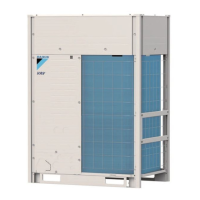
